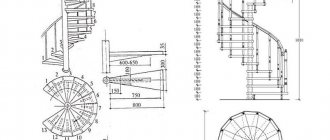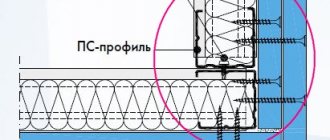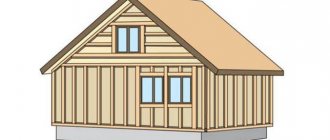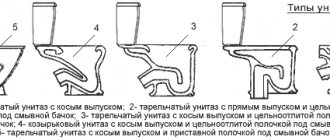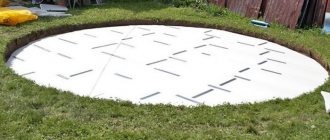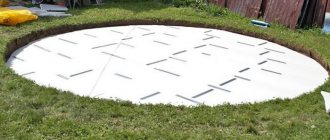In connection with the actualization of the problems of people with disabilities, the most important principles in the construction of residential and social buildings and industrial structures today are considered to be the following:
- ensuring equal accessibility to objects of various purposes for low-mobility groups of the population,
- fulfillment of legislative requirements during the construction of residential and industrial facilities with the aim of successful socialization of disabled people, their active participation in public life,
- implementation of the project “Barrier-free environment for people with disabilities”
All construction rules are regulated by the legal act “SP 59.13330.2012. Accessibility of buildings and structures for people with limited mobility,” which is the current edition of SNiP 35-01-2001. Both of these documents can serve as a starting point when designing objects taking into account their safe operation by people belonging to the category of “low-mobility groups of the population.” Some provisions of these rules differ from building codes. The first of the documents was written taking into account international standards, based on the relevant provisions of the UN Convention governing the rights of persons with disabilities. The second is the federal standard, approved by Order of the Government of the Russian Federation dated June 22, 2010 No. 1047-R.
Relevance of the problem
Few people think about the fact that 10% of all people are disabled.
Moreover, 1/3 of them can only move in a wheelchair. But such people are extremely rare on the street. One of the main reasons is the banal inability to leave the house, which is not designed with a wheelchair ramp. Currently, these structures are not available everywhere, which significantly complicates the life of disabled people. But even in equipped buildings they do not always meet the standard. Some even call boards thrown onto steps a ramp, but this is unacceptable. The parameters of this design, or, as it is also called, accessibility devices, are regulated by documents that specify all the requirements for its appearance and equipment.
Notes[edit | edit code]
- ↑ N. N. Vasiliev, O. N. Isaakyan, N. O. Roginsky, Ya. B. Smolyansky, V. A. Sokovich, T. S. Khachaturov.
Technical railway dictionary. - Moscow: State Transport Railway Publishing House, 1941. - 608 p. - ↑ Alexander Mikhailovich Prokhorov.
Large encyclopedic dictionary. - Scientific publishing house “Big Russian Encyclopedia”, 2000. - 1456 p. - ↑ Alexey Vladimirovich Skvortsov, Pavel Ivanovich Pospelov, Andrey Alexandrovich Kotov.
Geoinformatics in the road industry. — Alexey Vladimirovich Skvortsov, 2005-07-05. - P. 129. - 252 p. - ↑ S.K. Bogolyubov.
Drawing. — Ripol Classic. - P. 41. - 339 p. — ISBN 9785458308199. - ↑ R. Mubarakshin.
Do you know the road signs? All about road signs and markings. 2022 edition. — Litres, 2018-10-01. - P. 9. - 99 p. — ISBN 9785457656154.
GOST norms and requirements for ramps for disabled people
In our fast pace of life, it is quite difficult to manage to solve pressing concerns. This is even more difficult for people with disabilities, for whom the only way to climb the stairs is a ramp. Unfortunately, not many people in our society think about this, so ramps are very rarely found in the infrastructure of our cities.
So, what is the beautiful formulation – “an acute social problem – a ramp”? The concept of “ramp” began to be replaced by other devices for the movement of disabled people and mothers with baby strollers, ranging from all kinds of boards, plywood, bricks and ending with just cardboard layers.
Architecture and design
Search this blog
How to calculate and design a ramp?
How is the slope of a ramp calculated?
The slope can be expressed as a percentage, which is the result of the relationship between the height to be climbed (h) and the length of the horizontal plane (d) multiplied by 100.
Slope expressed as a percentage = (h/d) x 100
As an example, to overcome a height of 54 centimeters, we will use a slope of 6%, which will result in a horizontal plane of 9 meters. 6 = (0.54 m/d) x 100
To overcome the height of 90 centimeters, we will use a 6% incline, which will result in a 15-meter horizontal length.
Depending on regulatory requirements, the width of the gap between the handrails is taken to be at least 120 centimeters, as this allows a wheelchair to pass comfortably while holding onto both sides. When calculating the width of the ramp, it is important to take into account the maneuvering space of both a person with a wheelchair and a person with a stroller.
The materials used for the construction and finishing of the ramp must have a hard and non-slip surface that can be used in dry or wet conditions. In addition, at the beginning and end of the ramp, the ramp extends onto the horizontal surface of the sidewalk, which is distinguished by a strip of a different color along the entire width of the ramp, as a warning to people with limited visual ability. This also emphasizes the perimeter where the ramp opens, at least two meters from the walkway.
Source
Regulatory documents and requirements for the ramp
The creation of a comfortable environment for people with limited mobility in our country is regulated by various regulations. First of all, this is Art. 17 of the Constitution of the Russian Federation, Federal Law No. 181-FZ “On Social Protection of Persons with Disabilities” as amended on January 1, 2016, as well as the federal program “Accessible Environment”, aimed at fully ensuring by 2022 unimpeded access for people with disabilities to all urban infrastructure facilities.
In addition to federal documents, each region also has its own regulations that guarantee freedom of movement for people with limited mobility.
The basic requirements for the design of ramps are specified in the standards. We list the main parameters that a safe and comfortable entrance with a ramp must meet:
- The areas located at the top and bottom of the ramp must be larger than the standard dimensions of a wheelchair. This is necessary to provide the person with the opportunity for reversals and manipulations.
- For structures designed for one-way traffic, the span width should not be less than 0.9 m. For two-way traffic - no less than 1.8 m.
- The length of one ramp span should not exceed 9 m. If it is necessary to install longer structures, intermediate platforms are required.
- A ramp with a width of 0.9 m, which allows for a turn, must have an intermediate platform of 1.4 x 1.4 m.
- If the ramp requires a 180 turn, a platform of 1.8 x 1.5 m is required.
- A non-rotating structure with a width of 0.9 m requires a platform of 1.4 X 0.9 m.
- The platforms must be painted a different color from the ramp and have an anti-slip coating.
- It is imperative to observe the correct angle of inclination: in public places with a structure height of 0.8 m - 2.9 (5%); for large differences in height, a value of up to 5.7 (8-10%) is acceptable.
- On all sections of the ramp, special continuous handrails with a standard cross-section of 4 cm must be installed on the inside. At both ends of the ramp, the handrails must end with protrusions beyond the entire structure equal to 30 cm.
- The presence of sides on the sides is a prerequisite.
Where to complain?
Submit an application to the management company in two copies - you leave one, and take the second for yourself. Make sure that your copy is marked with the current date and the signature of the employee who accepted the application. This is a guarantee that your application will not be shelved.
Within 30 calendar days
The housing organization must provide an answer. If the answer turns out to be negative, even if all the conditions have been met on your part, that is, the support of the owners has been received, or it does not arrive within the prescribed period, contact the prosecutor’s office. The same applies to the authorities, if they refuse you under any pretext. Even the lack of money in the budget, which officials most often like to refer to, cannot be a valid reason for rejecting your request.
Judicial practice that has developed in Russia during the period of implementation of the “Accessible Environment” program also points to the responsibility of the Criminal Code to ensure the accessibility of IGN
to the residential premises they occupy.
Non-standard products
Unfortunately, it is not always possible to install a structure that meets all of the above requirements. There can be many reasons for this, for example:
- porch or building repairs;
- lack of free space;
- presence of obstacles in the way of movement, etc.
For these and other reasons, installing a conventional model may not be possible. To correct the situation, non-standard structures are sometimes installed. Of course, they may not meet many requirements, but they provide an opportunity for disabled people to enter the building.
The fact that products may not meet certain standards does not mean that you can tilt them 40° or forget about guards. When designing, the following points must be taken into account:
- minimum width – 85-90 cm;
- mandatory presence of handrails and barriers;
- permissible slope - 15%, maximum value - 18% (allowed only in extreme cases, if it is impossible to make a smaller slope);
- the maximum span length at a larger slope is 7 m.
Why do you need to know the roof slope?
Without an accurate understanding of this issue, it is impossible to understand slopes in degrees and percentages. What is affected by the slope of the slopes?
| Roof parameter | Impact on roof construction |
| Type of roofing material | Each roofing material has restrictions on the minimum angle of inclination. For example, on flat roofs (angle of inclination less than 10°) you can only use rolled roofing materials, for piece tiles the minimum inclination angle is 15°, etc. In addition, the amount of overlap between waterproofing and roofing materials depends on this parameter. |
| Wind and snow forces | The greater the angle of inclination, the less snow loads on the rafter system. With wind loads everything is more complicated. With small slopes of the slopes during strong gusts of wind, a lifting force acts on them; if the angle of inclination increases, an overturning force appears. Such changes in loads require a careful approach during the design and calculation of the rafter system. |
| Consumption of materials | The greater the angle of inclination, the larger the area of the slopes covering the building plan. Accordingly, the consumption of roofing materials increases. For example, with a slope slope of 60°, the consumption of materials is twice as high as when covering a building with a flat pitched roof. |
As can be seen from the table, the angle of inclination of the roof slopes is one of the most important technical parameters of the rafter system of a house. They pay attention to it from the very beginning of the construction project.
Requirements for structures
Entrance area
According to the requirements, ramps are equipped with horizontal entrance platforms of a certain size. The SP describes its parameters:
- width – at least 185 cm;
- depth – 1.4 m for doors that open into the house, and 1.5 m for doors that open outwards;
- the platform for turning a wheelchair is at least 220 cm wide.
Another regulatory document—SP—sets other requirements for the entrance area in terms of its size and equipment:
- there should be a canopy over the platform;
- In winter, if possible, the site should be heated;
- if the door opens outward, then the platform must have dimensions of at least 140*200 or 150*185 cm;
- the platform is made at least 220*220 cm in size.
Dimensions
Ramps for disabled people must be installed when the height difference is more than 1.5 cm. According to requirements, inclined slopes for wheelchairs are equipped on all stairs. If the height is more than 3 m, instead of ramps for the movement of disabled people, lifting devices are made.
The height of the ramp flight is made no more than 0.8 m. A side 5 cm high or a metal tube at a height of 10-15 cm is installed along the edge of the structure. If one-way traffic is expected along the ramp, then its width should be from 1.5 m, and if two-way - from 1.8 m (optimal width - 2 m).
Slope
According to the standards, the slope of the ramp for disabled people should not be more than 10%, in some cases - up to 15-18%. The longitudinal slope (as shown in the picture) should not exceed 10 degrees. Ramps are not installed on the stairs - it will be impossible to climb up such a “slide”.
Double-track options are convenient only where they are used by one person, for example, in a private house. In public buildings, where any stroller should be able to pass, continuous inclined slopes are made. If you need to make steps in the middle to lift a person who is helping a disabled person, then the tracks are wide, since different models of strollers have different distances between the wheels.
The dimensions of the structure can be easily calculated using the Pythagorean theorem. If the height difference H and the projection length of the inclined descent L are known, then we find the length of the ramp itself as the square root of H^2+L^2. Having found the length of the ramp, you can understand whether it is necessary to make horizontal platforms for it.
Installation Rules
To install a ramp in residential buildings, the consent of residents is not required. Every person with a disability has the right to a safer and more accessible space.
Other objects, such as billboards, must not be installed so that they block the entrance to the wheelchair ramp.
If a ramp is installed in a house, it should not start immediately from the entrance door of the apartment. There is a horizontal platform between it and the door.
It is not always possible to install ramps in public places and residential buildings in accordance with the regulations. Then you have to make them in violation of the rules, but the minimum design requirements must be observed:
- width - at least 85-90 cm;
- there must be handrails and barriers;
- a slope of 5% is allowed, a maximum of 18% (allowed only if it is not possible to make a smaller slope);
- the maximum march length with a slope exceeding 10% is 7 m.
Handrails are installed on the inside of the flight. They must be continuous along each section of the route.
Features of arrangement and operation
A generalization of the requirements for the arrangement of ramps will facilitate the design and installation of convenient structures for moving people with disabilities.
The structure, consisting of two ramps, is suitable for use exclusively by one disabled person using a wheelchair. This is explained simply. The spacing between the tracks is calculated based on the distance between the wheels on a wheelchair. The gap is different in different models, therefore, the width of the ramp is selected individually. It is optimal when a stationary structure for lifting in public places has a continuous surface. If it is necessary to leave a passage of steps for persons helping a disabled person move, the width of the channels should be sufficient to suit various models of wheelchairs.
When installing several flights of ramps, it is necessary to ensure that there is sufficient width on the horizontal platforms for a comfortable turn. The minimum dimensions are:
- platform width – 1.85 m;
- depth – 1.4 m (if the door opens inward);
- when the door is opened from the outside, the minimum gap is 1.5 m.
In addition to the conditions for maintaining the slope, the width of the structure and equipping it with handrails, there are other requirements:
- Ramps must have a straight shape. The screw design is permitted in exceptional situations.
- The distance between rest areas should not exceed 800 cm.
- The minimum load capacity of the structure is 350 kg/m
2.
- The maximum height of one span is 80 cm.
- When fully turning the screw structure, the minimum width is 200 cm.
- The edge of the structure is equipped with a side 5 cm high or a metal tube at a distance of 10-15 cm from the surface.
The handrails on the ramp for the disabled deserve special attention. What you should know in addition to the requirements stated earlier:
- for ease of movement, the handrails have a rounded shape;
- pipe diameter – from 3 to 5 cm, optimally – 4 cm;
- distance between the wall and the railing: for a flat surface - 4.5 cm, for a rough wall the minimum value increases to 6 cm;
- the gap between the handrails is from 0.9 to 1.0 m.
- the beginning and end of the inclined surface of the ramp for the disabled are marked with warning lines.
Advice! To reduce noise levels, the ramp is equipped with a damper tape.
In exceptional cases, a slope of 15% is allowed, the maximum permissible value is 18%.
Who should install ramps?
According to the law, in multi-apartment residential buildings, the installation of structures for low-mobility groups of the population must be carried out by a management company, HOA or housing office. In order for an entrance or public building to be equipped with a ramp, you can write a written application to the social protection authorities. Self-installation is not only impossible, but also prohibited, since during installation it is necessary to comply with all standards.
After sending the request, a specialist should go to the site. He will draw up an estimate and make a decision on which model is needed in a particular case. Review of the application may take one month.
List of documentation recommended for review:
| Name | Description |
| SNiP | contains instructions for the adaptation of residential buildings and socially significant facilities for people with limited mobility. As well as specific restrictions on the installation and parameters of ramps. |
| GOST R 51261-99 | contains technical requirements for stationary support devices. |
| JV | contains requirements for the entrance site. |
| JV | contains regulations on the accessibility of buildings and structures for people with limited mobility |
SNiP instructions strictly regulate permissible dimensions.
The material of the structure is also subject to certain requirements: fire resistance is at least R60, and fire resistance of fences is at least R120.
Ramp slope calculation
The angle of inclination is one of the most important problems when handing over a ramp to the customer. This value must be calculated in advance, and most importantly, correctly calculated. In the calculator you can calculate the angle of inclination of the ramp for a specific object.
Attention
With a march height of up to 80 cm - swing angle 2.86 ° With a march height of up to 20 cm - swing angle 5.71° For temporary structures with a march height of up to 80 cm - swing angle 4.76 °
Instructions:
Enter the parameters of the future ramp based on the object data. Parameters must be entered in meters. Click the "calculate" button. The angle of inclination of the ramp is calculated in degrees, and the length of the inclined platform in meters. You will also receive recommendations regarding the parameters that you have obtained.
Choosing the optimal value
Online slab foundation calculator
To calculate the required excess, you need to know the length of the entire pipeline and its purpose
To calculate the required excess, you need to know the length of the entire pipeline and its purpose. To avoid making calculations, you can use ready-made tables from SNiP, which give the standard slope for drain systems from various sanitary fixtures:
- To drain the bathroom, elements of 40-50 mm are used. The maximum distance from the drain to the siphon without ventilation is 1 ... 1.3 m. The slope is 1 in 30.
- The shower drain should be made of 40-50 mm pipes. Maximum distance –1.5…1.7 m. Excess – 1 to 48.
- The toilet drain is made from a 10 cm pipeline. The maximum distance is up to 6 m. The slope should be 1 in 20.
- Sink: elements measuring 40-50 mm, distance - 0 ... 0.8 m, excess - 1 to 12.
- Bidet: products with a diameter of 30-40 mm, distance - 0.7 ... 1 m, tilt - 1 in 20.
- Washing: pipeline with a diameter of 30-40 mm, distance - 1.3 ... 1.5 m, excess - 1 to 36.
The combined drain from the sink, shower and bathtub is made from products with a size of 5 cm. In this case, the maximum distance should be no more than 1.7 ... 2.3 m, and the slope should be 1 in 48. The optimal and minimum slope for pipes of a certain diameter is also standardized , connected to specific devices:
- A pipeline with a diameter of 4-5 cm coming from the sink can have a minimum slope of 0.025 ppm, and 0.35 ppm is considered optimal.
- Products with a cross section of 10 cm coming from the toilet should have a minimum slope of 0.012, and the optimal slope is 0.02.
- Elements measuring 5 cm, laid from the sink, can have a minimum excess of 0.025, and the optimal value is 0.035.
- Pipes with a cross section of 4-5 cm are laid from the washbasin and bathroom with a minimum slope of 0.025 and an optimal slope of 0.035.
Terminology
SNiP uses many names for certain things. Therefore, for greater clarity and understanding of the document, it is worth defining the following terms:
- adapted entrance - a special entrance for disabled people, equipped with a ramp;
Adapted entrance for disabled people.
- curb, railing - side railings of the structure that facilitate climbing;
- dimensions – dimensions of the product (for example, height, length, etc.);
- disabled (here) – a person with a musculoskeletal disorder;
- march - the distance between two platforms;
Ramp with two flights.
- ramp - a structure (descent) for disabled people with a certain slope, designed for moving from one horizontal surface to another;
- pictogram – sign, symbolic designation;
- cross slope - angle of inclination perpendicular to the direction of movement;
- longitudinal slope - an angle parallel to the direction of movement.
Transverse and longitudinal slope.
What does the slope of the roof depend on?
- From the ability of the roof to protect the structure from external factors and influences.
- From wind - the greater the roof slope, the greater the value of the wind loads. With steep slopes, wind resistance decreases and windage increases. In regions and places with strong winds, it is recommended to use a minimum roof slope to reduce the load on the supporting roof structures.
- From the roofing covering (material) – For each roofing material there is a minimum angle of inclination at which this material can be used.
- From architectural ideas, decisions, local traditions - this is how in different regions preference is given for one or another roof structure.
- From precipitation : snow loads and rain in the region. On roofs with a large slope, snow, dirt and leaves will not accumulate in large quantities.
People's needs
Many people do not know why regulatory documents provide for the installation of ramps.
These structures are necessary for people with disabilities. At the design stage, it is necessary to take into account that: - the premises must be easily accessible to all people so that they can get into any building, house or apartment;
— it is necessary to ensure everyone has access to the necessary equipment and devices (for example, elevators);
— the local area must have all the necessary systems.
When designing, it is important to know all the standards that govern the installation of auxiliary structures. So, the slope of the ramp should be from 8 to 10%
In exceptional cases, it is allowed to be up to 18%. But in residential buildings that are equipped with accessibility devices, it can be 50% if they are located on stairwells inside the building. As a rule, they may have a removable or folding metal ramp.
It is also worth noting that houses and buildings can be equipped not only with ramps, the installation of which is regulated by special rules. To provide an accessible environment, ramps or ramps are quite suitable. But channels for wheelchair users, as practice shows, are useless.
Preparation for arrangement
Before you start doing anything with your land and making plans, you need to consider the territory and get to know it better.
You need to pay attention to some details:
The terrain of the site, the presence of unevenness and hills on it. The reliefs do not have to be leveled, as unusual design solutions can be made from them. You can make stone paths along the hills, and create a pond in the lowlands.
Location of cardinal directions. The amount of light and protection from winds depends on this. So it is better to plant all heat-loving plants on the south side.
Vegetation, tall trees, or bushes. A tall and wide tree on the site can be taken as the center of the composition. In hot weather, they protect well from the sun and retain moisture, so you can make a table or gazebo under the tree.
Water level It affects the quality of growth of some plants. So if any flowers or bushes won't grow, the soil may not be suitable for them. To make sure your gardens don't deteriorate, it's worth checking the groundwater level.
Setting up a site takes a lot of time, you need to be prepared for this. Plants constantly require watering, the soil needs to be plowed, and bushes need to be pruned. Therefore, farming will last a lifetime.
What is a ramp and different types of ramps
A ramp and a ramp are the same thing and have the same definition as inclined platforms, ramps or platforms connecting two horizontal surfaces of different heights. The concept of a ramp, applicable to wheelchairs and strollers, was adopted to devices made of two metal runners. A ramp is more often referred to as one or two wide platforms. But there is practically no difference between the devices.
Ramp
Any of the equipped types of ramps (ramps) for children's or wheelchairs must comply with the basic requirements of GOST, SNiP of the Russian Federation. On the other hand, the structure should not pose a danger to the life, health, or property of other people, especially the elderly, who also belong to the low-mobility group of the population. Some types of reclining wheelchairs cause serious conflicts between residents of high-rise buildings, while others meet all the safety requirements of both parties.
Ramp in a high-rise building
Fixed devices
- Stationary ramps are installed on steps, taking into account the architectural features of the building and terrain conditions. They are constructed from metal structures or concrete, can be single or double span, and must have railings. They do not always meet standard requirements and safety measures.
Stationary ramp
- Folding ramps can be folded and are not permanently located on a flight of stairs. This rigid structure rises vertically with the help of hinges and is fixed to the wall or railing with latches. The device installed in an apartment building provides free passage up the stairs and access to the railings for other residents. Folding devices are also used in public transport. Unfortunately, durable and lightweight models made of aluminum become objects of theft by hunters for non-ferrous metals.
Folding ramp
Removable devices
- Sliding telescopic ramps are lightweight, portable, universal structures in the form of two separate ramps. The assembled and disassembled weights and dimensions differ for different models, but they are all made of durable material, mainly aluminum, with a non-slip coating and can withstand a weight of 200–400 kg.
The devices are suitable for stairs, entering vehicles, and other heights inaccessible to a wheelchair. They are expanded to the required length; in some cases (overcoming thresholds) they can be used not expanded. Extending up to 3.5 m in length, when assembled they are very compact, on average 1.5 m.
Sliding telescopic ramp
- Roll ramps are becoming increasingly popular due to their ease of operation and compactness when folded when rolled into an easy-to-storage roll. It can be one solid or two ramps. The structures are light, durable, safe in any weather. The ramps are made from separate modules, so you can easily lengthen or shorten them yourself. Now this is the most convenient and simplest type of ramp for wheelchairs. Often used in places of public events.
Roll ramp
- Threshold ramps are small devices that can be made from a metal sheet for a specific threshold or can be folding, suitable for various small elevations.
Ramp for thresholds
Designs of stationary descents
A permanently installed ramp for wheelchairs is a building structure made of concrete, stone materials or metal that has a flat surface with a standard angle of inclination. At the top and bottom points of such a structure there are horizontal platforms for a possible stop after descent or ascent. They greatly facilitate the process of using an inclined driveway.
The requirements of the rules and regulations determine the installation of ramps in all cases of discrepancy between the horizontal lines of adjacent surfaces by more than 50 mm. If the height difference is more than 200 mm, the structure must consist of three main elements:
The dimensions of the stopping platforms and the width of the ramp must correspond to the dimensions of the strollers produced. If the length of the inclined descent is more than 9 meters, an intermediate turning platform is provided, from which the second marching ascent begins.
If the difference is less than 200 mm, horizontal platforms are not installed, and the passage structure is a simplified rolling bridge. In some cases, when space is extremely cramped, the construction of screw structures or the installation of mechanical lifts is allowed.
The path and areas from the outside must be fenced with stable railings with a standardized height. To ensure stability, a stationary ramp, like any capital building structure, must have a supporting foundation capable of bearing a given weight load.
How to calculate a ramp
The ramp, namely its angle of inclination, is mentioned in several documents, where in fact there are some discrepancies, these documents are SNiP 35-01-2001 (these are construction standards) and SP 59.13330.2012 (these are fire protection systems). So the construction regulations say 4.76 degrees, i.e. 8%, which occurs at a ratio of 1:12, but fire safety regulations say that you need 2.86 degrees, i.e. 5%, which occurs at a ratio of 1:20.
But these standards have already been clarified in the amendments to SP 59.13330.2012, it says that you can build in the range from 1:20 (2.86 degrees) to 1:12 (4.76 degrees).
Of course, 2.86 degrees will be more convenient!
By the way, it is unacceptable to make one route more than 8 meters long, this must also be remembered!
Now about the calculation:
The formula is not complicated, but a simple geometric one:
At the beginning (before making calculations), you need to study the document SP 59.13330.2012, this is an updated version of SNiP 35-01-2001 (accessibility of structures and buildings for low-income groups of the population).
This document clearly states the slope angle, taking into account the length of the ramp and, in general, in detail, the calculation methods, because the ramps are different and the materials used to make the ramps are different.
When making calculations, it is necessary to take into account not only the slope of the ramp and its length, but also the difference in height.
The slope angle is clearly regulated, there is nothing to calculate here.
The SP contains the following figures:
1:20 (2.86 degrees), this means that with a height difference of a meter, the length of the ramp should be 20 meters and the slope angle should be 2.86 degrees, with a height of half a meter, the length should be 10 meters, etc. .d.
1:12 (8%) that is, with a height difference of a meter, the length of the ramp should be 12 meters, and with a height of half a meter, the length of the ramp should be at least 6 meters, etc.
The slope angle of the ramp will be 4.8 degrees.
It is these standards that are used as a basis for calculations.
The slope angle can be calculated using this formula, nothing complicated.
A ramp in the general understanding is a structure for lifting people with limited mobility (disabled people, strollers). Various requirements are imposed on the construction of such structures (presence of handrails, intermediate platforms, design load), including such an indicator as the angle of inclination.
You can find the requirements for the angle of inclination in SNiP 35-01-2001 “ACCESSIBILITY OF BUILDINGS AND STRUCTURES
FOR SMALL-MOBILITY GROUPS” or Code of Rules SP 59.13330.2012 “Accessibility of buildings and structures for low-mobility groups of the population.”
The calculation of the ramp can be made using the formula: ramp slope = H / L, where: H is the height difference that must be equipped with a ramp, and L is the length of the horizontal projection of the inclined section of the ramp
Depending on the lifting height and purpose, different relationships (proportions) between the height difference and the projection length can be adopted:
Knowing the value of the height difference, it is very easy (Pythagorean theorem) to determine the length of the ramp.
To calculate ramps for disabled people, you should refer to the document called SNiP 35-01-2001 and SP 59.13330.2012. But there are discrepancies in these documents, for example, in SNiP 35-01-2001 the permissible slope of the ramp is 1:12 (or 8%), while according to SP 59.13330.2012 it is equal to 1:20 (or 5%). Based on the fact that SNiP 35-01-2001 is a national standard approved by Order of the Government of the Russian Federation of June 21, 2010 No. 1047-r, it should also be taken into account that if the customer does not put forward requirements for the ramp design according to SP 59.13330.2012, then it is possible offer clients the design and manufacture of ramps according to the standards specified in SNiP 35-01-2001, i.e.:
the permissible slope of the ramp is 1:12 (or 8%, or 4.76 degrees).
Calculations for the slope of the ramp are carried out using the formula: slope of the ramp = H / L, where: H is the height difference that must be equipped with a ramp, and L is the length of the horizontal projection of the inclined section of the ramp.
The following parameters are allowed for car ramps: the optimal ramp slope for cars is considered to be 15%, and the maximum allowable is 25%. Moreover, in enclosed spaces no more than 16%, and when placed outside buildings, in places exposed to atmospheric influences, the angle of inclination should not exceed 10%.
add to favorites link thank
Stationary ramps for wheelchairs and strollers
We offer production and installation of stationary ramps for children's and wheelchairs in Moscow and the Moscow region. From us you can order the production of ramps of various types that can satisfy the most demanding needs.
Stationary ramps
There are steps at the entrance to many residential, public and administrative buildings. So the entrance group looks very respectable and is a striking element of the facade, but at the same time, this solution is a big problem for people with limited mobility, which include young mothers with prams, pensioners and the disabled. We produce ramps for wheelchairs, which are successfully used in a wide variety of facilities: (residential apartment buildings, shops and shopping centers, cafes and restaurants, beauty salons and hairdressing salons, clinics and hospitals, banks and hotels, sports and entertainment centers, theaters and cinemas, schools and universities, kindergartens and other hard-to-reach places for people with disabilities). You can order and buy any type of ramp from us.
Stationary metal ramps
Ramp arrangement for disabled people:
Do not forget that all ramps are for sedentary groups of the population. Whatever their type and purpose, they must first perform the main tasks! Ensure unimpeded access for people with limited mobility to the facility
Therefore, it is very important to correctly calculate and design the correct angle of inclination of any stationary ramp. It is necessary to strictly determine the height of the differences in accordance with generally accepted standards and GOSTs, which is not always an easy task
It often happens that the adjacent area for constructing a ramp is limited by the size of the site and heights, then it is necessary to find the optimal solution using additional turning areas, which in turn must also comply with all the standards for the metal structure of the ramp.
Ramp for disabled people and strollers – competent design, manufacturing and installation:
In order for the ramp for prams to fully fulfill its purpose, namely, to facilitate access to urban infrastructure and residential buildings, it is extremely important that the design of ramps for the disabled, production and installation are carried out by competent specialists who have a good understanding of the task and are able to solve it in the most optimal way:
- Firstly, you should correctly calculate the angle of inclination of a stationary ramp for the disabled. Current regulations require that it be within 5-8%, and only in exceptional cases is it allowed to increase to 10%.
- Secondly, if the height of the ramp is significant, horizontal platforms should be provided on which you can rest.
- Thirdly, each ramp should be equipped with comfortable double-sided two-level handrails, which act both as a reliable fence and as an effective support. Often the area in front of the facility is limited in size and then it is necessary to design a ramp for the disabled with one or more turning areas in order, on the one hand, to make it easier for the limited-mobile population to get up and down, and, on the other hand, not to clutter up the entrance area too much for other visitors or residents.
How to calculate the angle of inclination and length of the ramp?
The slope of the ramp is calculated using the formula: (RAMP TILT = H / L), where: H – height, L – length of the inclined section of the ramp.
The permissible slope of the ramp is specified in the regulatory document SP 59.13330.2012 “Accessibility of buildings and structures for people with limited mobility” - an updated version of SNiP 35-01-2001, the document came into force on 01/01/2013.
The permissible angle of inclination of the wheelchair ramp should be no more than 1:20 (5% or 2.86°) and the length of one lift should not be more than 8 m and the height should not exceed 0.8 m.
In some cases, it is possible to increase the maximum slope of the ramp:
up to 1:12 (8% or 4.76°) - for temporary structures and infrastructure, provided that the height difference between horizontal platforms is less than 0.5 m and the length of one ramp flight is no more than 6.0 m,
up to 1:10 (10% or 5.71°) – with a difference in floor heights of less than 0.2 m.
Stationary ramps for wheelchairs and strollers
Manufacturing and installing ramps for disabled people is socially significant work. IPK "Triumph" offers to buy ramps for children's and wheelchairs at low prices in Moscow and the region.
Accessible environment for people with disabilities what kind of program
To make the existence of persons with disabilities easier and improve their quality of life, one of the relevant ministries (the Ministry of Labor) has developed a state "Accessible Environment" program. Every decade, amendments are made to it, bringing building standards closer to global ones, and obsolete parameters are replaced with modern ones.
- comfort of using objects;
- caring attitude towards people with disabilities and their problems in society;
- modernization of facilities and free access to them by MGN.
The program is currently in its fourth stage. Thanks to it, design rules have been developed, organizations of people with disabilities are making themselves known, disabled children have the right to amenities in schools, cafes and concert halls, and adults have the right to minimal amenities at work.
Accessibility Documents
The Convention on the Rights of Persons with Disabilities declares the state's commitment to the protection of persons with disabilities and MGN. Russia has joined the global agreements since 2014.
Guarantees in the Constitution - the fundamental law of the state (Article 27).
Codes, architectural rules, government regulations and building standards call for creating decent living conditions for these citizens. For improper execution on the state. officials are subject to fines, and considerable ones. And for everyone involved in the process.
Accessories for disabled people in the state. institutions
Not much time has passed since the Sochi Olympics, and society has managed to notice that disabled people can be strong and courageous. Every day for most of them is a battle between ordinary human desires and limited possibilities. To adapt to the needs of MGN, a toolkit has been developed that is available for use in both old-plan buildings and new buildings. Manufactured individually, aimed at the hearing impaired, blind or spinal sufferers with low mobility characteristics, approved for state use. institutions.
- Information systems.
- Tactile signs.
- Auxiliary means - equipment and components.
- Constipation. Boiler rooms and boiler rooms are locked and a warning is posted. After all, there are also those who are outwardly healthy, but with specific diagnoses: they strive to get into something.
All devices have hygienic certificates and can be used in institutions for the disabled.
About five percent of the usable space in premises designed for the needs of society (cafes, clinics, various services) is legally accessible to people with disabilities. In high-rise buildings there are resting places for MGN: a bench, a sofa in a clinic, a chair in an official’s reception area. What kind of area there will be for a disabled person is regulated by a set of rules (hereinafter referred to as SP). The mobility and illness of the visitor are taken into account; disabled people are located according to the principle: visible, audible, comfortable.
Accessible environment for disabled children at school
Most schools and gardens were designed 40-50 years ago. The needs of the younger generation for inclusion were not taken into account. Therefore, accessibility for them requires modernization: entrances, stairs, school grounds. Re-equipping toilets and ramps at the entrance are just the beginning. Public address systems, “closer” at the entrance, railings with rounded edges. The “accessible environment” at school includes materials and equipment: non-slip panels, rough tiles underfoot, navigation systems, sound and light beacons, tactile signs.
The standards require:
- In school toilets, a panic button is required next to the toilet for disabled people.
- Ideally, an elevator, or a mobile lift as an option.
- Next to the inclusion areas there are sensory rooms. Psychologists and other specialists working with special children are required to use sand therapy, light and color therapy, and other correction methods that affect sensory perception. The school will be able not only to teach, but also to heal the soul of the child.
- Additional equipment of schools and kindergartens with soft play sets, dry pools with bright balls or foam cubes, fiber optic systems, sound and musical equipment is necessary.
- Children with disabilities need mobile or frameless furniture that has permits and hygiene certificates, braille printers, and other adaptive devices for computer equipment.
- According to a personal program - classes in swimming pools or on exercise machines, in common rooms for physical therapy.
Children must develop. An example of this is the physics theorist S. Hawking. And genius creates joy from success, communication and a sense of relevance in a disabled child.
How to properly make an entrance to your garage
Before starting construction work, a preliminary calculation is carried out. On average, the correct exit should be 30 cm wider in width than the garage door. The size may vary depending on the wishes of the owner and the characteristics of the surrounding area.
The slope of the drive is calculated according to the standards described in SNiP. The average is approximately 15-20 degrees over the entire distance of the journey.
Before installation it is recommended:
- clear the area in front of the garage of debris;
- if there are communications, isolate them in special boxes or calculate the design taking into account their inclusion or bypass.
tilt angle
Handrails and railings
Ramp fencing diagram
An important detail is the handrails. They must be installed on both sides of the slopes
It is required to install railings at a height of 65cm and 90cm. It is important to make the handrails from wear-resistant materials that prevent your hands from slipping when lifting. Steel railings are not the most convenient, because... During the cold season they are difficult to use. It is best to use plastic, rubber or wood railing coverings. Handrails and railings are installed so that they do not reduce the size of the area of use on the flight planes. The fastening of the railings is carried out rigidly, for conditions of sufficiently high loads on them.
Railings LO-3 and OP-4
Railings OH-1 and OH-5
Ramps for temporary use and removable ones may not be equipped with handrails; in other cases, the installation of handrails and fences is necessary. They are made from tubular metal parts, providing them with sufficient rigidity and the possibility of reliable fastening, and the required dimensions. The most durable options are made from stainless steel. They do not lose their aesthetic properties during prolonged exposure to rainfall and intensive use. When using handrails made of other materials, the need for maintenance and periodic painting must be taken into account.
Railing OP-1
Railings OP-2 and OP-3
Strict compliance with regulatory requirements for the dimensions of elements allows the design to be comfortable.
Calculator for calculating the length of rafter legs
To calculate the length of rafter legs, it is more convenient to use a special online calculator - there are many services on the Internet with similar capabilities. It is based on the well-known Pythagorean theorem, which allows you to determine the length of the hypotenuse using the known legs.
One of the legs (for all types of roofs) is the height of the ridge, the ridge tie in a hip roof, the excess of the height of one edge for single-pitch structures. The second leg is determined by the type of rafter system, which is shown in detail in Fig. 13.
where 1 – pitched roof;
2 – gable roof;
3 – hip design;
4 – hip rafter system.
Figure 13. Number and location of rafters in different roof structures
To calculate, you need to select the type of roof, enter the values of the height of the ridge and the width of the building - all calculations will be performed by an online calculator that takes into account all the above dependencies.
Metal tile Grand Line Kredo, Polyester, wet asphalt (RAL 7024) 0.45 mmMetal tile with a rounded ridge shape and soft and even lines reflecting the Medium…
From 541 RUR/m²Read more
Metal tile Grand Line Modern, Polyester, signal blue (RAL 5005) 0.4 mmMetal tile in the Modern profile, the shape of which is close to the classic ceramic tile…
From 398 RUR/m²Read more
Metal tile Grand Line Classic, Polyester, signal blue (RAL 5005) 0.45 mmMetal tile in the Classic profile, the shape of which is close to the classic ceramic tile…
From 556 RUR/m²Read more
Metal tiles Grand Line Classic, Velur20, wet asphalt (RAL 7024) 0.5 mm Metal tiles in the Classic profile, the shape of which is close to the classic ceramic tile…
From 869 RUR/m²Read more
Metal tile Grand Line Classic, Polyester, moss green (RAL 6005) 0.45 mmMetal tile in the Classic profile, the shape of which is close to the classic ceramic tile…
From 556 RUR/m²Read more
Metal tile Grand Line Classic, Satin, red wine (RAL 3005) 0.5 mmMetal tile in the Classic profile, the shape of which is close to the classic ceramic tile…
From 579 RUR/m²Read more
Metal tile Grand Line Kamea, Polyester, red wine (RAL 3005) 0.45 mmMetal tile in a stylish and modern profile Kamea coated Polyester with a smooth look…
From 541 RUR/m²Read more
Metal tile Grand Line Kvinta plus, Polyester, moss green (RAL 6005) 0.45 mmMetal tile with a symmetrical profile and original grooves that increase rigidity and…
From 557 RUR/m²Read more
Types of ramps
1.Telescopic and sliding.
A stationary ramp is installed for a long time. This type of construction can be double- or single-span; such a ramp is located at the entrance to the room. Products of this type are manufactured individually, taking into account the characteristics of the installation site. Requirements for their installation are regulated by GOST.
The folding design can be folded, for this reason it is installed in a place where space is a little limited. If the need arises, the product is folded and moved away so that it does not block the main passage. In this case, the ramp is fixed to the wall or railings using special devices.
The group of removable structures includes ramps, roll-on ramps, telescopic and sliding ramps.
Roll-up ramps are relatively small in size and can be rolled up like a rug. The products are quite convenient due to their mobility and compactness.
The telescopic ramp is universal and can be installed on any flight of stairs.
If we talk about ramps, they are also small in size. They are usually used when a disabled person needs to overcome an obstacle, for example, a curb.
Now it’s time to move on to the question: what are the standards for ramps for disabled people in public buildings?
What should the ramp slope be?
The most important thing about a ramp is the degree of slope. It is measured as a percentage and has the following indicators:
- current GOST requirements indicate that the slope angle should be 5% or 2.9°. The lifting height of the ramp should be 80 cm;
- if there is an uneven floor and a difference in its height of 20 cm, you can increase the slope angle to 10% or 5.7° (this is allowed by SNiP standards);
- if the ramp is installed for a short time, the vertical rise of its structure does not exceed 50 cm, and the length is 60 cm, then the slope angle can be made at 8% or 4.8°.
Normative documents
Safety and ease of movement are a priority when installing a ramp. For this purpose, regulatory documentation has developed requirements, compliance with which is mandatory when installing the structure. The main characteristics of the ramp include:
- permissible slope angle;
- width and length of the structure;
- dimensions of areas for convenient access for wheelchairs;
- presence of handrails.
These and many other conditions are set out in detail in SNiP and GOST.
SNiP 01/35/2001
SNiP requirements regarding ramps for disabled people contain the following points:
- The maximum height of the lifting structure (one flight) should not exceed 0.8 m. The angle of inclination should be less than 8%. If the height difference is less than 0.2 m, the permissible slope is 10%.
- To move a wheelchair user unilaterally, the width of the ramp can be 1.0 m; if it is necessary to organize two-way traffic, the width increases to 1.8 m.
- The size of the turning area for a disabled person on the horizontal section of the ramp is at least 1.5 m.
In addition, SNiP is regulated by:
- Requirements for the material from which ramps are constructed. The lower limit of their fire resistance is R60, for enclosing elements - R120.
- Equipping structures higher than 0.45 m with handrails. The height of the enclosing elements is 0.7 and 0.9 m. Their size exceeds the length of the ramp by 30 cm on both sides.
- At a distance of 60 cm in front of the inclined surface, the area should be grooved or have a contrasting color.
Compliance with the requirements of SNiP also provides for the presence of 5 cm high sides along the ramp to prevent the cane or the disabled person’s feet from slipping.
SP 59.13330
The 2012 Code of Rules is a revised and amended version of SNiP from 2001. It tightened the requirements for the installation of ramps for wheelchair users. Key points to note are:
- The new requirements provide for a structure slope of no more than 5%. In the previous version of SNiP this figure was 8% (proportion 1:12). Therefore, if the technical order does not indicate compliance with the requirements of SP 59.13330, they are guided by SNiP 2001, since this document has priority.
- The length of the lifting structure for disabled people (one flight) should be no more than 9.0 m.
- The width between handrails is at least 0.9 m.
Attention! If the total distance for lifting a disabled person exceeds 36.0 m, or the height of the structure is planned to be more than 3.0 m, care should be taken to install a lifting device. - Regarding the horizontal platform for turning in a stroller, there are also differences from SNiP 2001. The minimum dimensions allowed are 1.5x1.5 m, the distance between the enclosing surfaces in the area of intensive use is 2.1x2.1 m.
- There is provision for double-sided fencing of ramps with handrails. The distance from the surface is 0.7 m or within 0.85-0.92 m. In this case, it is necessary to comply with the requirements of GOST R 51261 regarding the arrangement of stationary support structures.
Requirements for arranging areas in front of ramps:
- The structure must have a canopy and drainage.
- If icing is likely, it is advisable to ensure the platform is heated.
- The minimum dimensions of the turning area for a disabled person in a wheelchair are 2.0 x 1.4 m or 1.85 x 1.5 m (taking into account the opening of doors outwards).
GOST R 51261-99
GOST requirements relate to the arrangement of ramps with handrails. Their presence is mandatory if the height of the structure is higher than 15 cm, and the horizontal inclined surface exceeds 1.8 m. Moreover, the structure for disabled people is equipped with handrails on both sides. Their dimensions exceed an inclined plane of 300 mm on each edge. Handrails should have a rounded shape at the end or be firmly attached to the floor.
There are other regulatory documents that provide for liability for refusal to install a ramp or its improper arrangement. The fundamental one can be considered Resolution of the State Duma of the Russian Federation No. 175 of March 17, 2011, on the basis of which regions are obliged to develop their own package of legislative acts to facilitate the process of movement of disabled people.
This is interesting: Decorating the facade of a private house with your own hands: Ideas for the New Year
Ensuring an accessible environment
Taking into account the fact that many do not consider it necessary to equip their homes, buildings, and shops with accessibility devices, administrative responsibility was established at the legislative level for those cases when the manager refuses to install a ramp. Photos of such structures make it possible to choose the most suitable option.
Refusal to install an accessibility device may result in a fine being imposed on both individuals and legal entities. It’s not a big deal if it’s not possible to install a ramp. You can equip entrances to the entrance to buildings and premises using any other accessibility devices. At the same time, it is permissible to make structures in which disabled people can move only with accompanying persons. Federal executive authorities, municipalities, and authorities of each subject of the Federation must monitor compliance with these requirements.
For example, a folding ramp can be made at the entrances, the slope of which is 50%. It is clear that a person with disabilities does not have the opportunity to either unfold it independently or climb onto it. But he allows the wheelchair user to leave the house with an accompanying person. And in the absence of even such a design, this becomes impossible. After all, in order to lower or lift a person in a wheelchair, several people are needed to carry him in their arms.
Methods for calculating percentage slope
The unit of measurement for roll, depending on its magnitude, is degree, percentage, ppm - a thousandth of a whole number: 1‰ = 1/10% = 1/1000 of 1. The physical meaning of slope is the ratio of the height difference to the length of the section on which it observed. In fact, it is the tangent of the angle: the excess of 12 meters on a section of the road of one hundred meters is expressed by the value 0.12 (tangent) = 12% = 120 ‰. That is, to calculate the slope in ppm, you need to multiply the percentage by ten.
When carrying out planning work on a land plot, it is necessary to resort to measuring the steepness of the slopes. This can be done in several ways:
- With the help of a level, all the necessary measurements are taken, and then, using simple calculations, the slope is formed as a percentage. How to calculate: the height difference is divided by the distance between the measurement points, and the result is multiplied by one hundred percent.
- According to the plan of the land plot, if there are relief marks on it. The height difference between the required points is read from the drawing, and the distance is measured with a scale ruler. Further calculations are similar to the previous method.
Roofers are often faced with the need to determine the actual slope of a roof and know how to calculate the slope using a special tool called an inclinometer. The design of the device is simple: a frame is attached to the rail with a protractor and a pendulum fixed inside, which has a weight and a pointer. The base of the device is placed on the lower surface of the roof section being measured, and the arrow indicates the angle.
Types of structures
A ramp is an inclined plane that provides vertical movement for people with limited mobility. For obvious reasons, the slope of the plane is small; accordingly, the length of this staircase substitute is quite large.
There are 2 types of structures for this type of movement - removable and non-removable.
- Non-removable - structures that are somehow fixed in one place. In turn, they are divided into 2 groups: stationary - already quite familiar options in cities, which are installed at the entrance to the house, going down to the metro or into an underground passage, and the like. Stationary ones do not change their position and shape;
- folding - placed in residential buildings where it is not possible to build another option.
- telescopic - the structure extends, the length depends on the number of extended sections;
All such products are manufactured based on accepted standards and never exceed the maximum permissible values.
Features of manufacturing ramp metal structures for transport.
Car ramps are also used to perform loading and unloading operations, allowing you to quickly and easily move cargo into the vehicle interior, body or wagon. As a result, labor productivity and speed of work completion increase. Manufacturing time depends on the complexity of the metal structure and its overall dimensions.
Modern manufacturers are engaged not only in the production of metal structures, but also in the development of projects for the production of ramps of any complexity and configuration. Ramps are used at various industrial, production and public facilities, in garages and driveways.
Dimensions of the ramp structure
This is the second important criterion that needs to be paid special attention to. What does the state standard say about this?
- The ramp must be equipped with two horizontal platforms: one at the bottom at the entrance, the second at the top. Their dimensions should be slightly larger than the dimensions of wheelchairs for the disabled in terms of free movement on them. And these are the minimum sizes.
- There are two types of ramp designs, based on the span width. If one-way traffic is organized through the device, then the minimum width should be 90 cm. If traffic is planned to be two-way, then the size is doubled.
Attention! For ease of passage along a two-way ramp, it is recommended to install railings in the middle of the span (along)
If the ramp is a structure of several spans, then a platform must be built between the flights. Its purpose is to allow wheelchairs to be turned around freely. So the dimensions of the site are as follows: length at least 1.5 m, width at least 1.8 m or 3.6 m. That is, the first width is for one-way traffic, the second is for two-way traffic.
Determining the angle of inclination
The correct slope of the ramp is one of the key points in arranging a convenient structure for the disabled. Since the definition of slope in regulatory requirements is presented in various ways, let’s consider them in more detail:
Despite the strict requirements of building regulations, non-standard slopes are sometimes allowed. It is acceptable in the following situations:
- In the case of a temporary ramp installation (during the repair or reconstruction of a building), if its height does not exceed 0.5 m and the gap between the platforms is no more than 6 m, the slope can be 8% or 1:12, which is equivalent to 4.8 o.
- If the height of the structure does not reach 0.2 m, the slope is permissible in the proportion of 1:10, which is 10% or 5.7 o.
A summary of the stated requirements is clearly presented in the following table:
Devices for the safe movement of people with disabilities are made of high-strength steel. Depending on the installation location, they are divided into:
Durability and convenience
Strength and durability depend on the reliability of the tilt design. To lighten the weight and ease of folding, the runners can be made of aluminum profile or wood. The distance between the runners is at least 78 cm (in the axes). Slopes made in this way do not require additional finishing other than painting. Painting should be done taking into account the color scheme of the room in which it is installed. It should have a neutral, discreet color (eg grey) with yellow signal stripes on the surfaces at the beginning and end of the inclined plane. They are most often installed for strollers in residential buildings.
It is important to pay attention to the solution of the tilting mechanism, which ensures reliability and ease of operation for the entire structure


